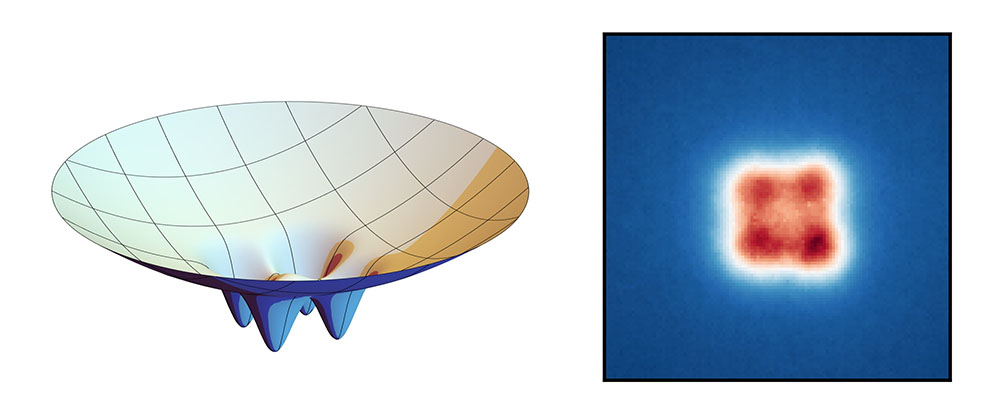| Sep 02, 2024 |
Researchers create an 'imprint' on a super photon
(Nanowerk News) Thousands of light particles can merge into a type of “super photon” under certain conditions. Researchers at the University of Bonn have now been able to use “tiny nano molds” to influence the design of this so-called Bose-Einstein condensate. This enables them to shape the speck of light into a simple lattice structure consisting of four points of light arranged in quadratic form. Such structures could potentially be used in the future to make the exchange of information between multiple participants tap-proof.
|
|
The results have now been published in the journal Physical Review Letters ("Bose-Einstein Condensation of Photons in a Four-Site Quantum Ring").
|
 |
| By creating indents on the reflective surfaces (shown on the left in an exaggerated form; the reflective surfaceis facing upwards), the researchers were able to imprint a structure ontothe photon condensate (right). (Image: IAP, Universität Bonn)
|
|
When a large number of light particles are cooled to a very low temperature and simultaneously confined in a compact space, they suddenly become indistinguishable and behave like a single super photon. Physicists call this a Bose-Einstein condensate and it normally resembles a blurry speck of light.
|
|
“However, we have now managed to imprint a simple lattice structure on the condensate,” says Andreas Redmann from the Institute of Applied Physics (IAP) at the University of Bonn.
|
|
The researchers at the IAP create super photons by filling a tiny container with a dye solution. The side walls of the container are reflective. If the dye molecules are excited with a laser, they produce photons that bounce back and forth between the reflective surfaces. These light particles start off relatively warm. However, they repeatedly collide with the dye molecules as they move between the reflective surfaces and cool down until they finally condense to form a super photon.
|
Unevenness on the reflective surfaces influences the design of the condensate
|
|
“The reflective surfaces are normally perfectly smooth,” explains Redmann. “We decided to deliberately add small indents to them, which figuratively speaking provide more space for the light to collect in them.”
|
|
This effectively imprints a structure onto the condensate – almost like when you press a mold with one closed side downwards into a sandbox: If you lift it up again, you can still see the imprint of the mold in the sand.
|
|
“In this way, we have managed to create four regions where the condensate prefers to stay,” says Redmann.
|
|
It is as if you were to divide a bowl of water between four cups arranged in quadratic form. In contrast to water, however, the super photon will not necessarily split into four smaller portions. If the cups are positioned closely enough together so that the light particles can pass quantum mechanically back and forth between them, it remains as one single condensate.
|
|
This property could be used, for example, to create so-called quantum entanglement. If the light in one cup changes its state, it will also impact the light in the other cups. This quantum physical correlation between the photons is a basic requirement for making the exchange of information – such as discussions or secret transactions – between several participants tap-proof.
|
|
“By deliberately changing the form of the reflective surfaces, it is theoretically possible to create Bose-Einstein condensates that are split between 20, 30 or even more lattice sites,” explains Redmann. “This would allow us to make the communication between lots of participants in a discussion tap-proof. Our study has shown for the first time how certain emission patterns can be deliberately created for use in a specific application. This makes the method extremely interesting for many different technological developments.”
|

